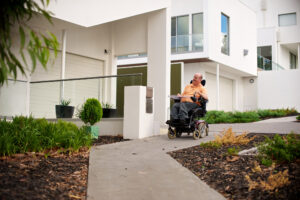Everything you need to know about Specialist Disability Accommodation
To move into your own house or a shared home with disability supports, you need to find a suitable place and secure proper funding. One type of funding you need to consider is Specialist Disability Accommodation (SDA).
Here, we take a closer look at SDA funding: how it works and how you can start finding your new home.
What is SDA funding?
SDA funding is money towards a practical and accessible home for people with extreme functional impairment or high support needs.
There are four types of SDA homes available. These are known as Design Categories.
- Improved Liveability – Homes with a ‘reasonable level of physical access for people with sensory, intellectual, or cognitive impairment’.
- Fully Accessible – Homes with a ‘high level of physical access for people with a significant physical impairment’. This may include wheelchair access in the bathroom, kitchen, and external areas.
- High Physical Support – Homes with a ‘very high level of specialised design and physical access’ may include ceiling hoists, assistive technologies, communication devices or emergency power solutions.
- Robust – Homes with good physical access, impact-resistant materials and safety features like retreat areas for participants and staff.
The SDA application process will determine which home category is right for you based on your individual needs.
Who is eligible for SDA funding?
You must meet the following criteria to qualify for SDA funding from the NDIS:
- You have an extreme functional impairment or high support needs.
- You can demonstrate that SDA will help you pursue your NDIS goals.
- You can highlight how the SDA will provide you with opportunities to help improve your independence, quality of life, and wellbeing.
- Your request is reasonable and necessary.
The best way to show these you meet these criteria is with an occupational therapy (OT) assessment highlighting your NDIS housing goals. The evaluation must show how a home designed with accessibility in mind will improve your wellbeing, prevent long-term health deterioration and build your capacity.
How do I apply for SDA funding?
Step 1: Housing Assessment Report
Your OT must do a comprehensive assessment to determine if you’re eligible for funding to apply for SDA funding. It will take between 12 to 15 hours to finish and highlight things like what type of house will best meet your needs.
Step 2: Supporting documents
It’s a good idea to include supporting documents with the assessment. These documents might include:
- A letter of support from your GP, a specialist doctor, physiotherapist, OT, speech pathologist, and other allied health practitioners.
- A Housing Plan – this is a report from your Support Coordinator or OT describing your current home and living situation. It will outline what your needs are and what you need from your future home.
Step 3: Apply to the NDIA
Once you have all your reports and support letters ready, you can apply to the NDIA for SDA funding.
You must complete the Home and Living Supports Request Form and provide the NDIA along with your supporting documents. You can do this by email, post, via your Local Area Coordinator or in person at the nearest NDIS Office.
If you have a Support Coordinator, they can help you with the application. Learn about our Support Coordination service.
What happens if I am approved for SDA funding?
Once your SDA funding application is approved by the NDIA, you can start looking for a new home.
There are several ways to search for SDA homes in your area.
Private rental properties
NDIS has an SDA housing finder online that allows you to search for vacancies by location.
However, many SDA vacancies are advertised on Housing Hub and Go Nest. These websites are online housing portals that allow you to create a profile. You’ll be notified when new homes become available.
You can also directly approach your local SDA providers and Supported Independent Living providers about their SDA housing vacancies.
Some providers may advertise on the websites listed above. Still, others will list vacancies on their own website, use a local real estate agent or source tenants through support coordinators.
You can ask your support coordinator about housing providers they know who may have housing that might be suitable for you.
Government-owned housing
You can find government-owned disability housing by going to Housing Vic, Housing SA or the New South Wales Department of Communities and Justice.
Buy your own home
It is possible to use your SDA funding to buy your own SDA compliant home. In this situation, you would be a “self-provider” of SDA. Your home must still meet SDA dwelling enrolment requirements and guidelines. You must also register as a self-provider with the NDIS Quality and Safeguards Commission.
Should you buy a home that’s not a purpose-built SDA dwelling, the NDIS may provide funding for you to install home modifications and assistive technology that you need.
Upgrade your existing home
You might own your own home already. Perhaps, you bought it before you needed something more accessible. In some cases, you can use NDIS funding to make home modifications to make your house more suitable for your needs.
Where to next?
Think moving into SDA is the right choice for your future? To start the ball rolling, talk to your NDIS Local Area Coordinator or your Support Coordinator.




